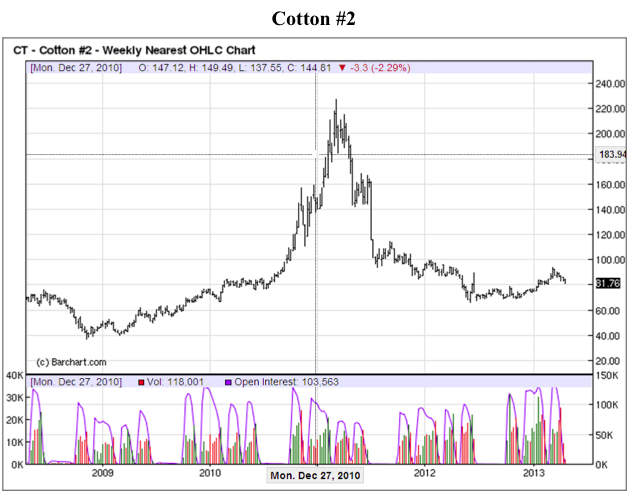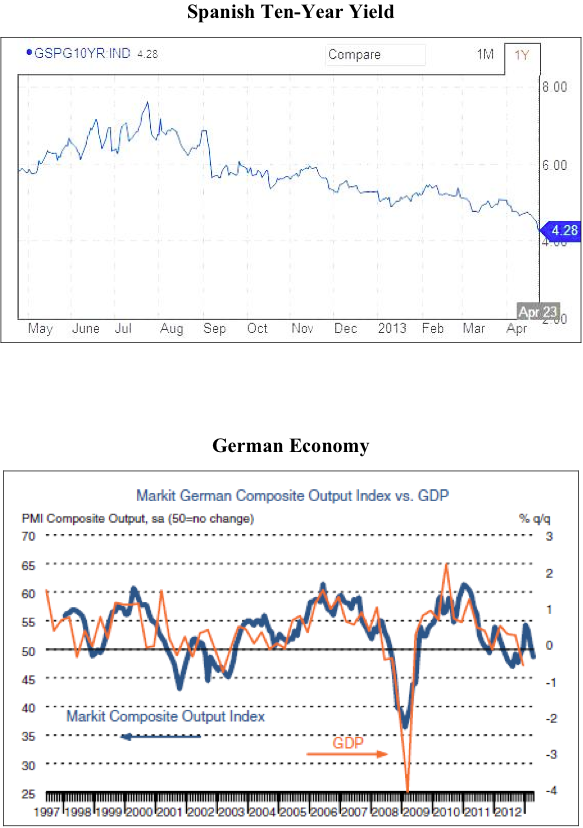The Gold Report: What does it mean that leading stock market averages have been in Uptrends, while commodities markets are in Downtrends?
James Dines: Our “Sell” signal on China’s economy in The Dines Letter (TDL) of Sept. 16, 2011, is still stubbornly resisted by the mainstream press, which instead persists in calling for 7.5% growth by China Since we perceive China as a barometer for the commodities markets, it followed that there would be a decline in raw-materials prices.
We find it astonishing that we seem to be the only voice in the world’s mainstream press calling commodities markets in the last two years “a crash.” Cotton down 70% from its high is merely one example. It’s not in the world’s headlines yet, but we find it remarkable that virtually all commodities are down, worldwide, even including precious metals, oil, uranium and rare earths. How could leading market averages be in Uptrends, presumably forecasting a business upturn, even while commodities have plunged? After all, to market things, they need to be made, with commodities, do they not? China was the biggest consumer of commodities, so we infer China’s economy is in trouble, especially its banks and real estate, as predicted in our 2013 Annual Forecast Issue (pages 26-29; also The Dines Letter of Mar 15, 2013, page 7). So our next “Buy” signal on China will be crucial in attempting to discern the cyclical advent of the next raw-materials upturn.
Because of excessive government interference with interest rates, those desperate for income—including pension funds—have pushed prices of virtually all secure sources to nosebleed heights. When the Fed eventually does raise interest rates, the bond bubble will be pricked and the stampede to get out of bonds should be like a herd of elephants attempting to exit through a revolving door. What to do in such a bond market crisis? Aside from TDL’s blue-chip recommendations, we always recommend dispersing assets in several “friendly” countries. Also, diversifying in golds and silvers, including Saint-Gaudens double-eagle gold coins, rather than just keeping capital entirely in fiat currencies.
The world is in what we call “The Second Great Depression,” comparable with the first one, in the 1930s. As laid out in my final business book, “Goldbug!,” doubling the money supply in 1922 to pay for World War I caused a great inflation that after 1929 was corrected by the First Great Depression, in the 1930s. The similar printing of enormous quantities of paper money, not backed by anything except more paper, has also resulted in the current Great Deflation, still deepening, worldwide. The soup kitchens of the 1930s have been replaced by food stamps, but the resemblance is not coincidental.
Realizing that Keynesian economics failed to end unemployment after the 1932 crash, until World War II began around 1940, enabled us to predict with specific clarity that it would not work these days either. Indeed. Historically, large quantities of printing-press money has failed to reduce the downward trend of Americans with jobs in recent years. Few believed our prediction of “The Coming End of the Age of Jobs,” or that it would lead to “The Coming New Social Order,” but it is already unfolding. Unemployment in Europe already ranges between 20% and 50%, depending.
It is difficult for investors to protect themselves in this situation, but we cover it as best we can. We have recommended blue-chip stocks that have a dividend yield higher than that of U.S. Treasury paper, because they are proxies for institutions seeking to park their cash in areas other than overpriced bonds. That should end when the Federal Reserve finally allows interest rates to rise, but its fanaticism in continuing to suppress rates despite the Keynesian method not working represents a triumph of hope over experience—and will not end well.
Especially shocking is the delusion that adding inflation to a deflation would somehow cancel each other out, but is in fact the futile attempt to cure a problem with its cause. Overprinting paper runs at increasing risk of an eructation of “hyperinflation”—please note it is a word not used anywhere in the mainstream press these days. Predicting a hyperinflation is so daring in today’s environment that we might be mistaken, so we will have to get closer toward the end game to be more confident of it. We hope we are mistaken.
TGR: What will be the next big sector?
JD: We refer you to Dinesism #38, of the 65 that guides our methodology: “Rich or poor it’s good to have a lot of cash.” And you may feel free to quote us on that. Also, parking some long-term capital in gold and silver, especially during pullbacks, would be useful if a hyperinflation eructs.
James Dines is legendary for having made correct forecasts that were in complete contradiction to the rest of the financial community. He is the author of five highly regarded books, including “Goldbug!,” in addition to his popular newsletter, The Dines Letter, and videotaped educational series. Dines’ highly successful investment strategies have been praised by Barron’s, Financial Times, Forbes, Moneyline and The New York Times, among others.
Want to read more Gold Report interviews like this? Sign up for our free e-newsletter, and you’ll learn when new articles have been published. To see a list of recent interviews with industry analysts and commentators, visit our Streetwise Interviews page.
DISCLOSURE:
1) JT Long conducted this interview for The Gold Report and provides services to The Gold Report as an employee.
2) James Dines: I was not paid by Streetwise Reports for participating in this interview. Comments and opinions expressed are my own comments and opinions.
3) Streetwise Reports does not make editorial comments or change experts’ statements without their consent.
4) The interview does not constitute investment advice. Each reader is encouraged to consult with his or her individual financial professional and any action a reader takes as a result of information presented here is his or her own responsibility. By opening this page, each reader accepts and agrees to Streetwise Reports’ terms of use and full legal disclaimer.
5) From time to time, Streetwise Reports LLC and its directors, officers, employees or members of their families, as well as persons interviewed for articles and interviews on the site, may have a long or short position in securities mentioned and may make purchases and/or sales of those securities in the open market or otherwise.






















